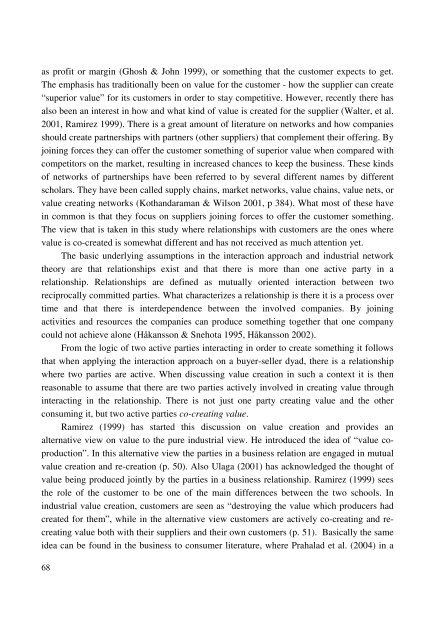Value Co-Creation in Industrial Buyer-Seller Partnerships ... - Doria
Value Co-Creation in Industrial Buyer-Seller Partnerships ... - Doria
Value Co-Creation in Industrial Buyer-Seller Partnerships ... - Doria
- No tags were found...
Create successful ePaper yourself
Turn your PDF publications into a flip-book with our unique Google optimized e-Paper software.
as profit or marg<strong>in</strong> (Ghosh & John 1999), or someth<strong>in</strong>g that the customer expects to get.The emphasis has traditionally been on value for the customer - how the supplier can create“ superior value” for its customers <strong>in</strong> order to stay competitive. However, recently there hasalso been an <strong>in</strong>terest <strong>in</strong> how and what k<strong>in</strong>d of value is created for the supplier (Walter, et al.2001, Ramirez 1999). There is a great amount of literature on networks and how companiesshould create partnerships with partners (other suppliers) that complement their offer<strong>in</strong>g. Byjo<strong>in</strong><strong>in</strong>g forces they can offer the customer someth<strong>in</strong>g of superior value when compared withcompetitors on the market, result<strong>in</strong>g <strong>in</strong> <strong>in</strong>creased chances to keep the bus<strong>in</strong>ess. These k<strong>in</strong>dsof networks of partnerships have been referred to by several different names by differentscholars. They have been called supply cha<strong>in</strong>s, market networks, value cha<strong>in</strong>s, value nets, orvalue creat<strong>in</strong>g networks (Kothandaraman & Wilson 2001, p 384). What most of these have<strong>in</strong> common is that they focus on suppliers jo<strong>in</strong><strong>in</strong>g forces to offer the customer someth<strong>in</strong>g.The view that is taken <strong>in</strong> this study where relationships with customers are the ones wherevalue is co-created is somewhat different and has not received as much attention yet.The basic underly<strong>in</strong>g assumptions <strong>in</strong> the <strong>in</strong>teraction approach and <strong>in</strong>dustrial networktheory are that relationships exist and that there is more than one active party <strong>in</strong> arelationship. Relationships are def<strong>in</strong>ed as mutually oriented <strong>in</strong>teraction between tworeciprocally committed parties. What characterizes a relationship is there it is a process overtime and that there is <strong>in</strong>terdependence between the <strong>in</strong>volved companies. By jo<strong>in</strong><strong>in</strong>gactivities and resources the companies can produce someth<strong>in</strong>g together that one companycould not achieve alone (Håkansson & Snehota 1995, Håkansson 2002).From the logic of two active parties <strong>in</strong>teract<strong>in</strong>g <strong>in</strong> order to create someth<strong>in</strong>g it followsthat when apply<strong>in</strong>g the <strong>in</strong>teraction approach on a buyer-seller dyad, there is a relationshipwhere two parties are active. When discuss<strong>in</strong>g value creation <strong>in</strong> such a context it is thenreasonable to assume that there are two parties actively <strong>in</strong>volved <strong>in</strong> creat<strong>in</strong>g value through<strong>in</strong>teract<strong>in</strong>g <strong>in</strong> the relationship. There is not just one party creat<strong>in</strong>g value and the otherconsum<strong>in</strong>g it, but two active parties co-creat<strong>in</strong>g value.Ramirez (1999) has started this discussion on value creation and provides analternative view on value to the pure <strong>in</strong>dustrial view. He <strong>in</strong>troduced the idea of “ value coproduction”. In this alternative view the parties <strong>in</strong> a bus<strong>in</strong>ess relation are engaged <strong>in</strong> mutualvalue creation and re-creation (p. 50). Also Ulaga (2001) has acknowledged the thought ofvalue be<strong>in</strong>g produced jo<strong>in</strong>tly by the parties <strong>in</strong> a bus<strong>in</strong>ess relationship. Ramirez (1999) seesthe role of the customer to be one of the ma<strong>in</strong> differences between the two schools. In<strong>in</strong>dustrial value creation, customers are seen as “ destroy<strong>in</strong>g the value which producers hadcreated for them” , while <strong>in</strong> the alternative view customers are actively co-creat<strong>in</strong>g and recreat<strong>in</strong>gvalue both with their suppliers and their own customers (p. 51). Basically the sameidea can be found <strong>in</strong> the bus<strong>in</strong>ess to consumer literature, where Prahalad et al. (2004) <strong>in</strong> a68
















